Contents
Winter garlic has certain advantages over summer (spring) varieties. It has a richer aroma and taste, larger heads. And besides all this, planting garlic in the fall is convenient because the earth at this time is loose and not frozen, as it happens in early spring. However, it is possible to count on a high-quality and long-term harvest of winter garlic only if it is properly planted and further cared for.
Cooking the garden
Before planting garlic, the area for its cultivation must be properly prepared. The crop needs fertile, well-drained soil for successful growth and good yields. Garlic grows well in loamy, acid-neutral soil that needs to be fertilized when digging.
Digging the beds for winter garlic is carried out about a month before planting, at the end of August, so that the fertilizers have time to completely dissolve and soak into the soil.
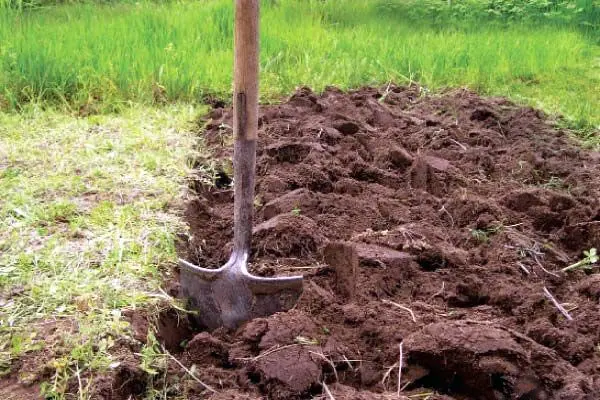
You should know that different types of fertilizers are used for each soil composition:
- We introduce organic matter and mineral mixtures into loamy soil. For 1 m² you need 1 bucket of humus (you can use compost), as well as 1 glass of lime, 1 tbsp. a spoonful of superphosphate plus the same amount of nitrophoska.
- If we plant the teeth in heavy clay soil, then in addition to all the above fertilizers, we add another 1 bucket of peat for every 1 m² to improve the structure.
- When we plant garlic in fertile soil (chernozem), the fertilizer consumption decreases – it is enough to add 1 bucket of humus for every 1 m² plus 30 g of superphosphate and 20 g of any potash mixture, but additionally it is necessary to add sand or peat to improve drainage properties.
All fertilizers must be distributed over the surface of the soil, and then dig the area to a depth of 25–30 cm. Next, we level the bed, compact it a little, and then treat it with a disinfectant solution of vitriol. A preparation is prepared in the proportion of 40 g of powder per 10 liters of water. The site is processed at the rate of 1 liter of solution / 1 m². After all the activities, we cover the bed with a film. You can plant teeth in such prepared soil in about a month.
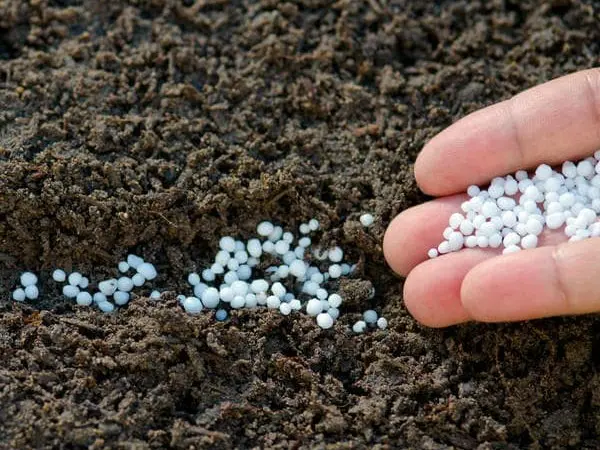
Choosing the right place
For planting winter varieties of garlic, you need to choose open, unshaded areas where the sun shines intensely for at least half a day. The location of the beds in a sunny place will accelerate seedlings in spring and maturation of heads in summer. It is also important that the site is dry, not flooded with groundwater and, if possible, be on a hill. If you place the bed in a lowland or on a slope, rainwater can stagnate, which will lead to rotting of the bulbs.
For garlic, it is important who was his predecessor in the garden. The culture grows well in the area where legumes, pumpkin crops, greens, and cabbage used to grow. An important condition for high yields is the observance of crop rotation.
You should not plant garlic for two years in one place. In addition, it is possible to return the garlic to the previous garden only after 3-4 years.
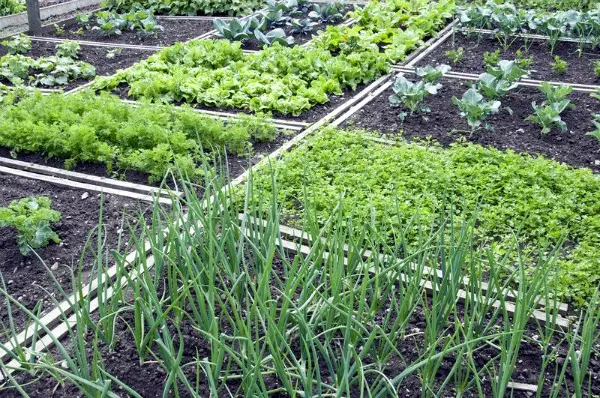
Preparing garlic for planting
Preparing winter garlic for sowing does not take much effort and time, since a freshly harvested crop is used for sowing. In this case, the main task is only the disinfection of the seed (teeth).
First you need to select the highest quality, well-dried bulbs, very carefully divide them into teeth, trying not to damage the seed. For planting, large or medium teeth should be selected. Small specimens should not be planted, as they may simply not germinate, or they will noticeably lag behind in growth.
To disinfect the teeth, two solutions are used in succession:
- first saline (3 tablespoons of salt / 5 l of water) – the teeth are kept in it for 2 minutes;
- then the teeth are placed in a solution of copper sulfate (1 tablespoon of powder / 10 liters of water) and incubated for 1 minute.
After these simple procedures, garlic is planted in prepared soil.
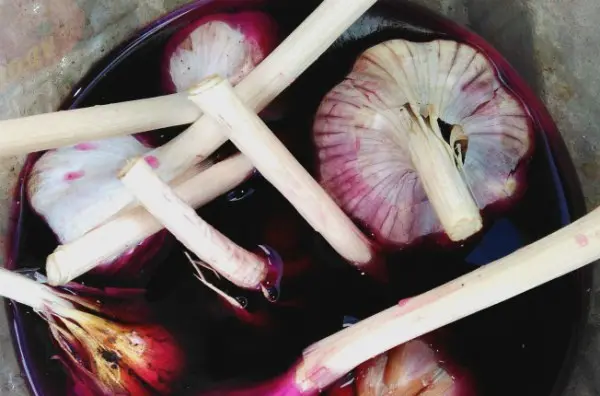
Landing
Winter garlic should be planted 1–1,5 months before the onset of the first frost. This time is enough for the teeth to germinate roots and penetrate 10–12 cm deep into the soil, but at the same time, sprouts do not have time to appear. For regions with a temperate climate, the planting period falls on the end of September – the beginning of October. In the northern regions, winter garlic can be planted after September 20, and in the southern regions after October 10. It is advisable not to miscalculate with the planting date, since early sown garlic can germinate before the cold weather, and planted late will freeze.
The landing process itself is as follows:
- On a bed dug up and filled with fertilizers, we make longitudinal furrows up to 8 cm deep at a distance of 20 cm from each other.
- At the bottom of the furrow we pour a little sand or ash. This procedure is necessary in order to protect the teeth from direct contact with the soil and thereby prevent their decay.
- Next, we plant garlic cloves bottom down at a distance of 10-12 cm for large specimens, and 8-10 for smaller ones.
- We plant the teeth so that the distance to the soil surface is 4–5 cm.
- Then we cover the planted teeth with earth and lightly tamp.
If you plant garlic in moist soil, you do not need to water it. If it so happened that in autumn the earth is very dry, then the bed can be watered.
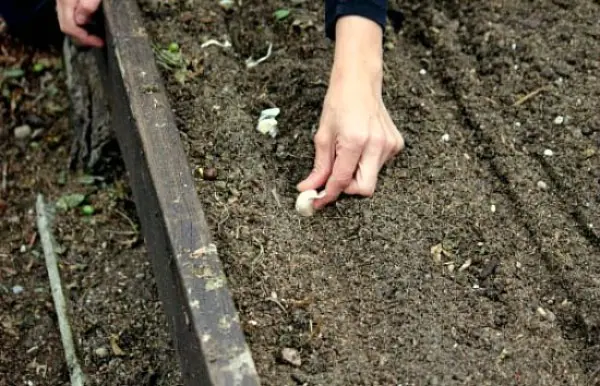
Care
There is nothing complicated in caring for winter garlic. All major events are postponed until spring, and in the fall, you only need to fill the garden bed with humus or peat, which will serve for plants not only as fertilizer, but also as a reliable shelter from the cold. The beds are covered with a 2-cm layer of organic matter when 2-3 weeks have passed after the planting of the teeth.
Since the sprouts of garlic planted in autumn appear very early – as soon as the snow melts and the soil warms up to 5–6 ° C, care for the beds begins in early spring. When the first shoots of garlic appear, the bed must be loosened to a depth of 2-3 cm and re-mulched with peat or humus.
Garlic beds are watered throughout May and June, and in July, 2–4 weeks before harvest, watering is stopped. Watering should be done as the soil dries out. Irrigation rates depend on the weather:
- if the air temperature is moderate, watering is carried out 1 time in 8–10 days at the rate of 10–12 l / m²;
- when the weather is very hot and there is no rain, the beds are watered more often – 1 time in 3-5 days;
- in rainy weather, garlic does not need watering.
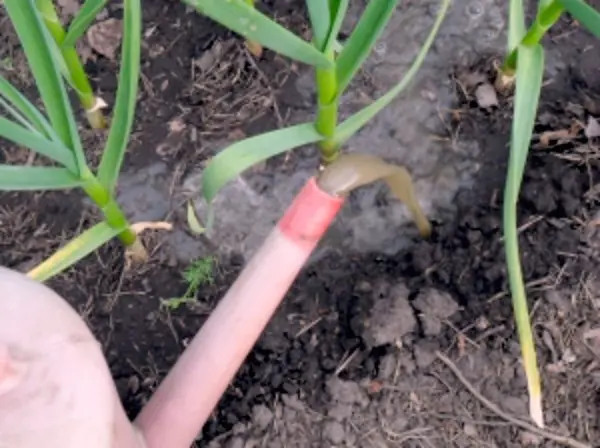
Throughout the spring period and until July, garlic needs top dressing, which can be combined with watering. There should be at least three main dressings:
- the first is carried out when the plants reach 3–4 leaves – liquid mullein is used, or special soluble fertilizers are watered from a watering can at the rate of 2–3 l of solution / 1 m²;
- the second time top dressing is carried out somewhere 2 weeks after the first – the plants are watered with a solution of nitrophoska, which is diluted in a proportion of 2 tbsp. spoons / 10 liters of water, the liquid consumption is 3 liters / 1 m²;
- the last time winter garlic is fed in early July, about 2 weeks before digging the bulbs – superphosphate is used at the rate of 2 tbsp. spoons / 10 l species, for every 1 m² they spend 3-4 liters of solution.
Winter garlic is quite resistant to diseases, but sometimes it is affected by microbial diseases such as powdery mildew, rust, or attacked by harmful insects: mites, caterpillars, bears, codling moths. To prevent this scourge, plants can be sprayed with a solution of ash, whey.
It is not recommended to use insecticides for garlic, as it quickly absorbs not only useful substances from the soil, but also poisonous ones.
Video “Autumn planting garlic”
This video is about how to plant winter garlic in autumn, how to choose the optimal planting time, prepare the soil for planting, etc.









